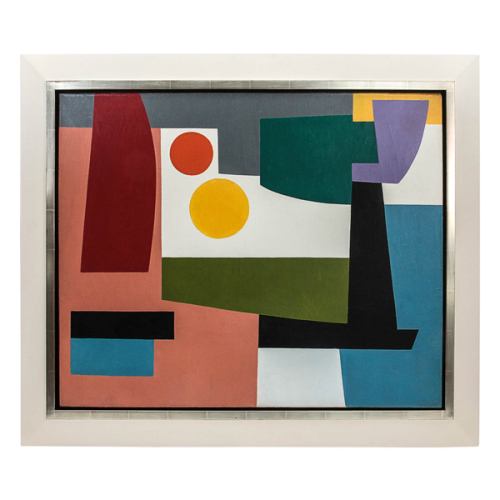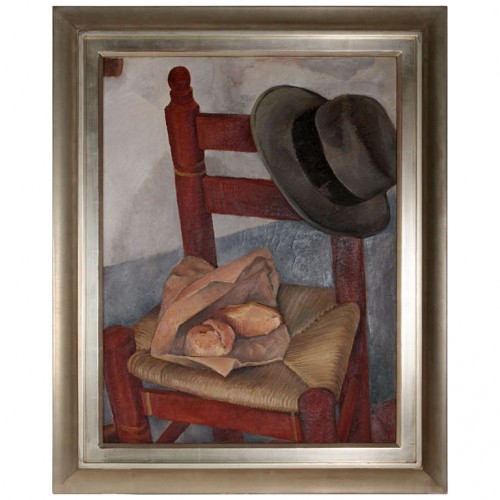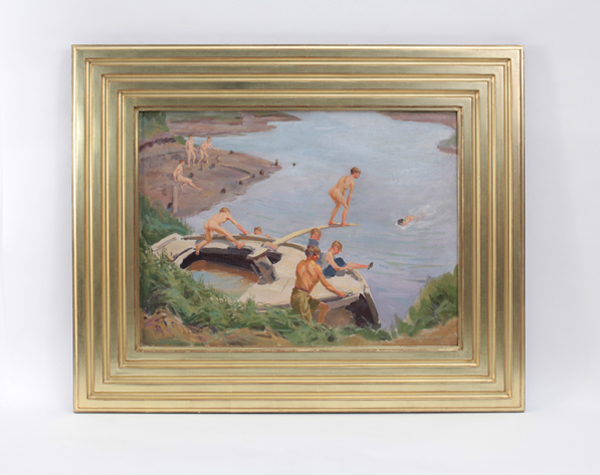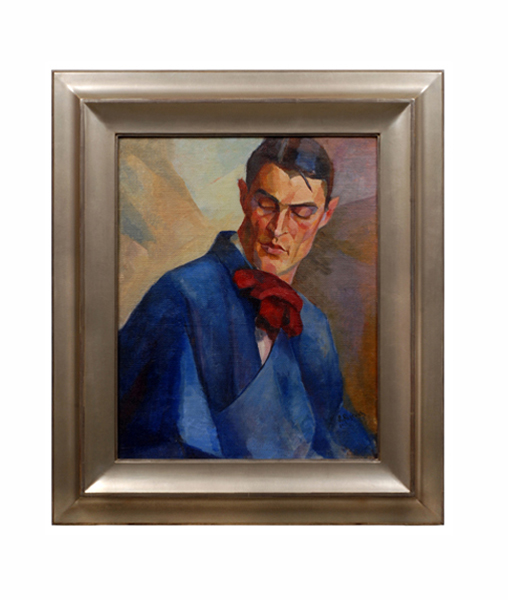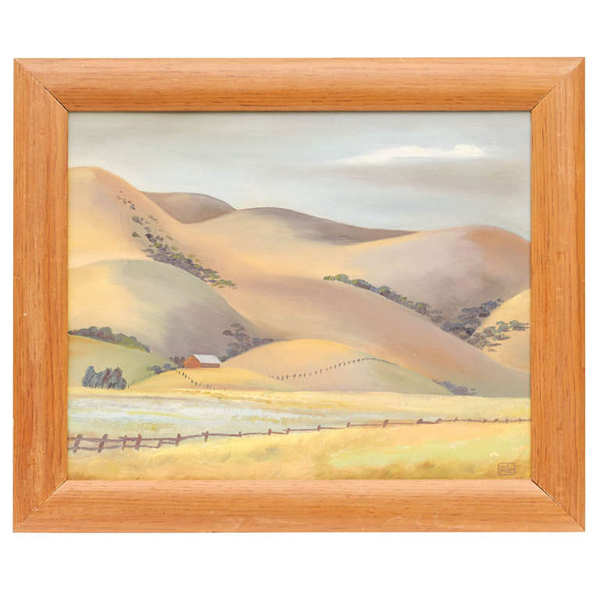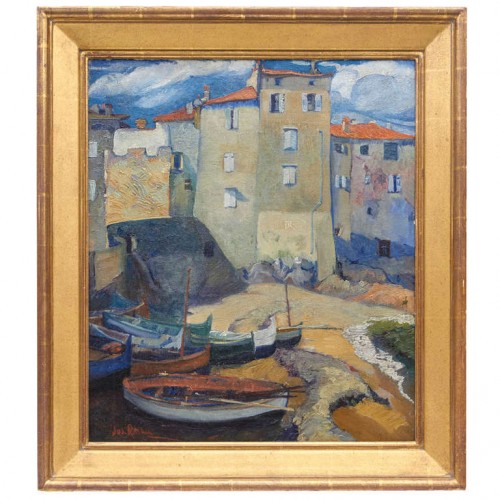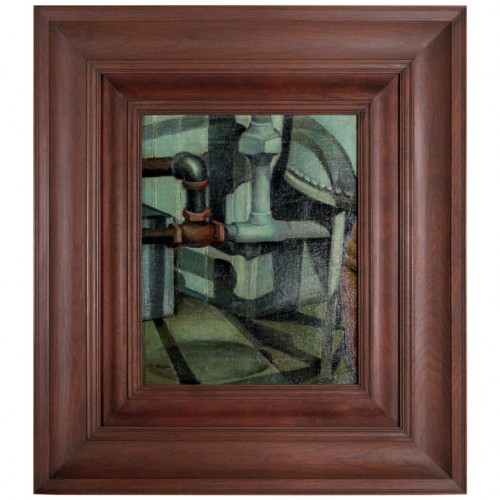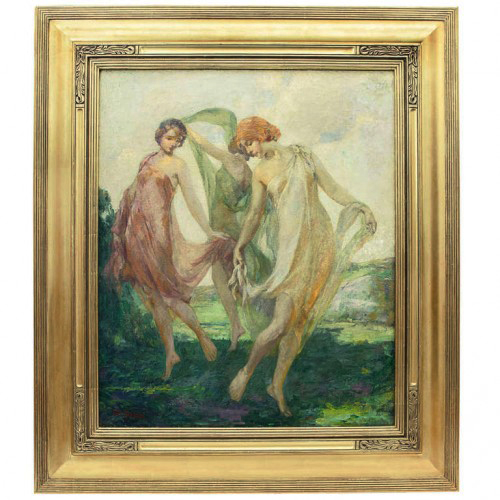Oil on canvas
-
Roger Georges Andre Duval, “La Chambré” Oil on canvas 1924
ROGER GEORGES ANDRÈ DUVAL (1901-?) Meudon (Seine-et-Oise), France
La Chambré 1924
Oil on canvas
Signed and dated: ROGER DUVAL XXIV(lower left)
Exhbited: Paris, Salon des Indépendants, 1926, no. 1122
For more information see: Dictionnaire des Peintres, Sculpteurs, Dessinateurs et Graveurs, Vol. 4, E. Bénézit (Paris: Librairie Gründ, 1976).
Painting: H: 23 2/3” x W: 36 1/5”
Framed: H: 35” x 47 5/8”
Roger Duval painted in a modernist figurative style and beginning in 1920 regularly exhibited at the Salon d’Automne and the Salon des Indépendants in Paris. In 1925 he was awarded a prize by Paul Poiret for a painting entitled Conversation and again in 1926 for another painting entitled Bal Musette. Also in 1926, La Chambrée (1924) was exhibited in Paris at the Salon des Indépendants. By 1928 Duval’s technique had evolved into a moderninst/cubist style and a group of his paintings were featured in an Exposition of Painting and Sculpture in Boston, MA.
It is interesting to note Duval’s shared vision with Picasso in their depiction of peasant figures in repose. Their full-bodied, voluptuous and sensual forms illustrate both artists’ sculptural approach to painting in the early 1920s. However by the mid-1920s Duval and Picasso’s painting styles evolved from these softer, rounded shapes into more angular, abstracted forms.
-
Duval Eliot “Still life”, Oil on canvas, wood frame c. 1945
DUVAL ELIOT (1909-1990) USA
Still life c. 1945
Oil on canvas, wood frame
Signed: Duval Eliot (lower right)
Painting H: 30” x W: 24”
Frame H: 38” x W: 32”
Duval Eliot, nee’ Ruby Duval Bearden, was born in Arkansas, and at a young age moved with her family to California. After going to Hollywood High School, she attended The Los Angeles Trade Technical College (then known as Frank Wiggins Trade School), studying Commercial Art and Design. While there, she began her art career as a men’s fashion illustrator. Then, because of her immense interest in art, immediately enrolled in Art Center School in Los Angeles, being one of their first students. She studied landscape painting (watercolor and oil), portrait, life drawing and illustration with Barse Miller and with Joseph Henniger, life drawing. At Art Center she continued studying all facets of commercial art and simultaneously worked at the Columbia Advertising Agency designing newspaper layouts and fashion illustrations for the major Los Angeles department stores such as I. Magnin, The Broadway, I. Miller, Wetherby Kayser, and Sak’s in Beverly Hills.
Throughout the 1940’s, Duval continued to create watercolor landscapes of Southern California and the West, while illustrating for J.J. Hagarty. Commercially, her prime focus was free-lance illustration, which could be created with a young child in tow, finding interesting work at the “Western Family Magazine,” for whom she did illustrations for over ten years. She also illustrated children’s storybooks and textbooks for MacMillian and L.W. Stinger publishing houses, meanwhile creating Fashion Advertisements and billboards in full color for Phelps & Terkel for several years and billboards for Silverwoods Department Store. For this work, Duval received the Western Art Directors Award in 1946.
During the post World War II years, Duval honed her fine art techniques. She studied with such notable artists as: Barse Miller, Hardy Gramatky and Ejnar Hansen (watercolor) and also with Hansen, (landscape & portrait painting in oil). In 1948, in The Fourth Annual Los Angeles Exhibition at The Greek Theater in Griffith Park, she won 1st Prize for her watercolor entitled “End of the Trail” among her peers of 326 entrants for painting, including Francis De Erdely, Lorser Feitelson, Conrad Buff, James Couper Wright, Frode N. Dann, Joshua Meador, Dan Lutz, and Chas. Payzant. She also studied painting with Conrad Buff, J.C.Wright, Design and Abstract Painting with Leonard Edmonson, and later, painting in acrylic with 2 years of intensive color with Guy MacCoy and silk-screen Serigraphy with Mario De Perentes. Duval also became close friends with Milford Zornes.
Duval became active in “The Southern California Designer Craftsmen” (S.C.D.C.) She won many awards and exhibited extensively throughout the 1950’s and 1960’s at Barnsdall Municipal Art Gallery, Pasadena Art Museum (paintings and enamels}, Gallery 333 on La Cienega. In the 1940s, she turned towards more formal subject matter including landscape and still life and honed her fine art techniques in watercolor, oil, acrylic, and printmaking.
She participated in several group exhibitions in the Los Angeles area in the late 50s and early 60s. Her work was featured in solo exhibitions at the Jack Carr Gallery in Pasadena in 1976 and the Brand Library Gallery in Glendale in 1988.
Duval was also an active member and on the boards of “The Pasadena Society of Artists”, ”The Los Angeles Art Association”, “Women Painters of the West”, as well as S.C.D.C., participating in numerous group (Design 6, 7, 8, and 9 at the Pasadena Art Museum) and one man shows in the vicinities of Pasadena, Glendale, Santa Barbara and Claremont. She was represented in Paris by two silk screen serigraphs at The Exposicion Internacionale des Federacion Femenine at The Museum des Arts Decoratifs in 1971.
Duval Eliot was also represented in The Los Angeles County Art Museum’s show “MADE IN CALIF” in 2001 with “Chavez Ravine” and “3rd St. Traffic”.
-
Michiel Gloeckner “Old Town No. 2”, Oil on Canvas 1960
MICHIEL GLOECKNER (1915-1989) Germany / USA
Old Town No. 2 1960
Oil on Canvas
Signed: MG (lower right corner)
Canvas: H: 14 1/16” x W: 11 1/16”
Framed: H: 19 9/16” x W: 16 9/16”
Price: 32,000
Michiel Gloeckner, known for his highly refined, balanced abstract, geometric style derived from natural forms, was the son of a well-known art collector. He graduated from the University of Dresden with a degree in mathematics and art history. He received a degree from the Royal Academy of Dresden where he studied under Otto Dix. Paul Klee also influenced Gloeckner’s work. After WWII Gloeckner moved to New York City. He continued to maintain a studio in New York at 115 East 70th Street, even after he moved to West Cornwall, Connecticut where he spent the later years of his life.
EXHIBITIONS
Gallery Seventy-Five, New York 1955, 1956, 1958
Jacques Seligman Galleries, New York 1960, 1961, 1962
Wadsworth Atheneum 1960
Wesleyan University 1961
Philadelphia Art Alliance 1962
Philadelphia Academy of Fine Arts 1963
World House Galleries, New York 1963, 1962, 1965, 1966
Columbus Gallery of Fine Arts 1964
Brooks Memorial Museum 1965
Munich Kunstverein 1966
Galerie Heseler, Munich 1967
Munich Museum of Modern Art 1968
Museum of Northern Arizona 1970
Galerie 5, Paris 1972, 1973, 1974, 1975, 1976
Galerie Oxy, Geneva 1973
United Nations, Geneva 1974
Gallery Contemporary Masters, New York 1978, 1980
MUSEUM COLLECTIONS:
Pinakothek der Moderne Munich
Allentown Art Museum
Museum of Modern Art, Stockholm
-
Robert Breer “Untitled” Oil on canvas 1950
ROBERT BREER (1926-2011) USA
Untitled 1950
Oil on canvas, white-gold leaf and lacquer frame
Marks: Untitled, 1950, Robert Breer, 26×32, No. 29 in a circle (paper label)
Provenance: Robert Breer, Private Collection, Chicago
Canvas: H: 25 3/4” x W: 32”
Framed: H: 32 1/4” x W: 39″
“Breer acknowledges his respect for this purist, “cubist” cinema, which uses geometric shapes moving in time and space”
Robert Breer’s career as an artist and animator spans 50 years and his creative explorations have made him an international figure. He began his artistic pursuits as a painter while living in Paris from 1949-59. Using an old Bolex 16mm camera, his first films, such as “Form Phases”, were simple stop-motion studies based on his abstract paintings.
Breer has always been fascinated by the mechanics of film. Perhaps it was his father’s fascination with 3-D work that inspired Breer to tinker with early mechanical cinematic devices. His father was an engineer and designer of the legendary Chrysler Airflow automobile in 1934 and built a 3-D camera to film all the family vacations. After studying engineering at Stanford, Breer changed his focus toward handcrafted arts and began experimenting with flip books. These animations, done on ordinary 4″ by 6″ file cards have become the standard for all of Breer’s work in fim.
Like many of his generation, Breer did early work influenced by the various European modern art movements of the early 20th century, ranging from the abstract forms of the Russian Constructivists and the structuralist formulas of the Bauhaus, to the nonsensical universe of the Dadaists. As a result of his association with the Denise René Gallery, which specialized in geometric art, he saw the abstract films of such pioneers as Hans Richter, Viking Eggeling, Walter Ruttmann and Fernand Léger. Breer acknowledges his respect for this purist, “cubist” cinema, which uses geometric shapes moving in time and space.
In 1955, he helped organize and exhibited in a show in Paris entitled “Le Mouvement” (The Movement), which paved the way for new cinema aesthetics. During this period, Breer also met the poet Allen Ginsberg and introduced him to his film “Recreation” (1956), which made use of frame-by-frame experiments in a non-narrative structure. Although Breer resisted being labeled a beatnik, the film does capture some aspects of beat poetry and music.
When Breer returned to the United States in the late 1950s, the American avant-garde was thriving and films by Kenneth Anger, Stan Brakhage, Peter Kubelka and Maria Menken were creating a new visionary movement. Breer found kindred spirits within the New York experimental scene. As Pop Art emerged as a phenomenon in the 1960s, Breer befriended Claes Oldenburg and others. He worked on the TV show, “David Brinkley’s Journal”, filming pieces on art shows in Europe; at the same time, he made his debut documentary on the sculptor Jean Tinguely in 1961.
-
Jeffrey Hartman “Motobecane” Oil on canvas 1978
JEFFREY HARTMAN USA
“Motobecane” 1978
Oil on canvas
Signed: “Jeffrey Hartman ‘78”, “© 78 HARTMAN” (on the back)
Framed H: 26 1/2” x W: 18 1/2”
Price: $18,000
Belgian art dealer Isy Brachot coined the French word Hyperréalisme, meaning Hyperrealism, as the title of a major exhibition and catalogue at his gallery in Brussels in 1973. The exhibition was dominated by such American Photorealists as Ralph Goings, Chuck Close, Don Eddy, Robert Bechtle and Richard McLean; but it included such influential European artists as Gnoli, Richter, Klapheck and Delcol. Since then, Hyperealisme has been used by European artists and dealers to apply to painters influenced by the Photorealists. However, Hyperrealism is contrasted with the literal approach found in traditional photorealist paintings of the late 20th century. Hyperrealist painters and sculptors use photographic images as a reference source from which to create a more definitive and detailed rendering, one that often, unlike Photorealism, is narrative and emotive in its depictions. Strict Photorealist painters tended to imitate photographic images, omitting or abstracting certain finite detail to maintain a consistent over-all pictorial design. They often omitted human emotion, political value, and narrative elements. Since it evolved from Pop Art, the photorealistic style of painting was uniquely tight, precise, and sharply mechanical with an emphasis on mundane, everyday imagery. Hyperrealism, although photographic in essence, often entails a softer, much more complex focus on the subject depicted, presenting it as a living, tangible object. These objects and scenes in Hyperrealism paintings and sculptures are meticulously detailed to create the illusion of a reality not seen in the original photo. That is not to say they’re surreal, as the illusion is a convincing depiction of (simulated) reality. Textures, surfaces, lighting effects, and shadows appear clearer and more distinct than the reference photo or even the actual subject itself.
-
Victor Arnautoff, The Felt Hat, Oil on Canvas c. 1930
VICTOR ARNAUTOFF (1896-1979) USA
The Felt Hat c. 1930
Oil on canvas, white gold frame
Signed: V. Arnautoff, lower right
Exhibited: Art Center San Francisco, 1931 (see image of the review in the San Francisco Examiner, July 12th, 1931)
For more information see: The New Deal for Artists, Richard D. McKinzie (Princeton, NJ: Princeton University Press, 1973), Coit Tower, San Francisco : Its History and Art
Painting: H: 26” x W: 21”
Framed: H: 32 ½” x 27 ½”Price: $60,000
Victor Arnautoff created paintings and watercolors, focusing on portraits, still lifes and rural landscapes in his early years, and moved to more socially conscious themes later in his career. Arnautoff was a native of Russia, to which he returned during the 1960s after thirty years in the United States. He came to San Francisco from Russia via China, bringing his wife and children with him, and studied at the California School of Fine Arts studying with Ralph Stackpole and Edgar Walter before going to Mexico. There he worked as an assistant to the famous Mexican muralist Diego Rivera. During the 1930s, Arnautoff worked as project director and one of the artists selected to create the famed Coit Tower murals, he played a key role in determining the political and social content of the frescoes painted in the San Francisco landmark. His own contribution, City Life, appears to be a lively, non-political melding of downtown San Francisco scenes; however, closer study reveals two leftist newspapers on the newsstand, while the city’s most mainstream daily, the San Francisco Chronicle, is strangely missing. Arnautoff also painted frescoes in the Military Chapel at San Francisco’s Presidio, in the Anne Bremer Library of the San Francisco Art Institute, and in high schools and other buildings in the Bay Area. He was a professor of art at Stanford University from 1939 until his retirement in 1963.
-
Edmund F. Ward “The Swimming Hole” Oil on canvas c. 1930
EDMUND F. WARD (b. 1892 – 1991) USA
“The Swimming Hole” c. 1930
Oil on canvas
Marks: signed Edm. F. Ward (lower right); partial labels verso:Westchester Arts and Crafts Guild; 4 Edmund F. Ward
For more information on the artist see: Who Was Who in American Art,Peter Hastings Falk, ed. (Madison, Conn.: Sound View Press, 1985), p. 658.
Canvas H: 18” x W: 24”
Framed H: 27 9/16” x W: 33 9/16”
Price: $14,000
Ward studied at the Arts Student’s League with Edward Dufner, George Bridgeman, and Thomas Fogarty. He was an illustrator for several national magazines and books. In 1925, Ward exhibited an award winning work at the Art Institute of Chicago. He is perhaps best known for his WPA mural in the Federal Building, White Plains, New York.
-
Zygmund Sazevich “Portrait of Victor Arnautoff” Oil on canvas 1925
ZYGMUND SAZEVICH (1899-1968)
Portrait of Victor Arnautoff 1925
Oil on canvas
Signed: Z. Sazevich 1925 (lower right)
Framed: H: 34 5/16” x W: 29 9/16”
Price: $65,000
Zygmund Sazevich was born in Russia in 1899, and studied briefly at the University in Kazan in 1917, before traveling to Manchuria where he lived and worked as an actor and stage scenery painter. He emigrated to the U.S. via Japan in the early 1920s and entered the School of Architecture at the University of California, Berkeley, supporting himself by working as a house painter and helping stage plays for a local Russian theater company. Sazevich met Russian artist Eugene Ivanoff, and together they shared living quarters and studied at the California School of Fine Arts in San Francisco. Sazevich was awarded two scholarships, one in painting and one in sculpture. During the 1920’s Sazevich exhibited with the San Francisco Art Association, and in 1929 won first prize at their annual exhibit, followed by several sculpture commissions. That same year Sazevich and Ivanoff traveled to live and work in Paris. Back in San Francisco in 1931, his work was included in a show of garden sculptures at the California Palace of the Legion of Honor, along with works by Adaline Kent, Ruth Cravath, and others. By 1935 he was working as a W.P.A. muralist. Sazevich and his wife Zena, a decorator, purchased a home in the City, which they filled with Sazevich’s sculptures, woodcarvings, and hand-made furniture. In 1939 Sazevich exhibited at San Francisco’s Golden Gate International Exposition. His cast terrazzo sculpture Mississippi won the 1940 purchase prize at the annual San Francisco Art Association exhibition, and he had a one-man show at the San Francisco Museum of Art in 1941. During World War II, Sazevich worked in a shipyard creating wood patterns, and in later years he designed and made hand-blocked Christmas cards that were in great demand. His clients included celebrities such as Greer Garson, Joan Fontaine, and Red Skelton. From the late 1940s until the 1960s, Sazevich taught art classes, both at the California School of Fine Arts and at Mills College in Oakland. He continued to exhibit at the San Francisco Museum of Art through the 1950s, and in 1953 was featured in the museum’s Four Sculptors of the West show. Sazevich also had two solo shows at Mills College in 1950 and 1954, and a show at Raymond & Raymond in San Francisco in 1951. Zygmund Sazevich passed away in San Francisco in 1968. In 1982 his work was included in The Oakland Museum’s seminal exhibition 100 Years of California Sculpture.
Though his works are rare today, Zygmund Sazevich was a prolific, versatile and highly-regarded San Francisco Bay Area artist and instructor whose passion for his medium was evident not only in his sculptures and carvings, but also in his drawings and paintings. Sazevich believed that the two-dimensional rendering of the subject was integral to the process of sculpture, along with the necessity for the artist to have a feeling for the material with which he worked. His convictions were reflected in the great variety of woods, metals, and stone he used to create his sculptures, as well as in his paintings.
-
Jean Marion Gates Hall, “Napa Valley” Oil on canvas 1940
JEAN MARION GATES HALL (1911-2001) USA
Napa Valley 1940
Oil on canvas, original wood frame
Signed: with her monogram initials JGH (lower right)
Marked on back: Jean Gates Hall, June 18, 1940, Napa ValleyCanvas: H: 14″ x W: 17 1/4″
Framed: H: 17 1/2″ x W: 20 1/2″Price: $4,250
Born in Memphis, TN on May 19, 1911. Jean Gates studied at the Cummings School of Art in Des Moines. At age 14 she moved to Los Angeles with her family. There she continued at the Chouinard Art School while working for Warner Bros, Walt Disney, and Mintz Studios. Upon moving to San Francisco, she married writer James D. Hall in 1938. Her illustrations were used in her husband’s children’s books. She established a studio in the “Monkey Block” (now the Transamerica Pyramid) and was active in the local art scene. She later earned her B.A. degree at San Jose State University (1955) and M.A. degree at UC Davis (1966). Working in oil and watercolor, her painting style and subject matter evolved with the years from descriptive realism to linear pictures, and finally an entirely new medium called Magpage. Mrs. Hall was a resident of Oakland in the 1980s and died in Cedar Ridge, CA on June 23, 2001.
Exhibitions: Iowa State Fair, 1926; California State Fair, 1937; GGIE, 1939; Paul Elder Gallery (SF), 1939 (solo); NMAA, 1941; SFMA, 1942 (solo); De Young Museum, 1944 (solo); California WC Society, 1945-53; UC Davis, 1946, 1965 (solos); Kingsley Art Club (Sacramento), 1965.
-
Joseph Raskin, Seaside scene, Oil on Canvas c. 1920 -1925
JOSEPH RASKIN (1897-1981) USA
Seaside scene c. 1920 -1925
Oil on canvas, gold leaf frame
Signed: Jos. Raskin (lower left)
For more information see: Who Was Who in American Art,
(Madison, Conn.: Sound View Press, 1985), p. 505Canvas: 25 1/4” x 21 1/4”
Frame: 31 1/4” x 26 3/4”Price: $35,000
Born in Nogaisk, Russia, Joseph Raskin made a name for himself as a painter in New York City, where he was also recognized as an etcher, teacher and writer. He studied at the National Academy of Design and, in 1921, received a fellowship from the Louis Comfort Tiffany Foundation. A member of the American Artists Congress, Raskin’s work was exhibited at the Schervee Gallery (Boston) in 1927, Tricker Gallery in 1939, the Schneider-Gabriel Gallery in 1941, Steinway Hall in 1942, and the American Artists Association in 1945. Raskin’s work may be found in several museum collections including the Carnegie Institute in Pittsburgh, the Pennsylvania Academy of Fine Arts in Philadelphia, the Virginia Museum of Fine Arts in Richmond, and the Corcoran Gallery of Art and National Academy of Design, both in Washington, D.C.
-
Otis Oldfield, Water Pipes and Shadows, Oil on Canvas c. 1920
OTIS OLDFIELD (1890-1969) USA
“Water pipes and shadows” c. 1920
Oil on canvas, walnut frame
Signed: Otis Oldfield (lower left)
For more information see: Otis Oldfield 1890-1990, Centennial retrospective exhibition (San Francisco, CA: Inkwell Publishing, 1990).
Painting: H: 16 1/8” x W: 13”
Framed: H: 28 ¼” x W: 25 1/8”Price: $42,500
***The Metropolitan Museum of Art in New York owns a famous Gelatin silver print photograph by Morton Schamberg from 1916 entitled “God”. This image is akin to Duchamp’s “Fountain” and is an iconic Dadaist assemblage of plumbing pipes mounted on a miter box. The “Water Pipes and Shadows” painting by Otis Oldfield similarly brings a certain animation and personality to an under sink composition of mundane drain pipes in a sophisticated “Rayonist” or “Cubist” stylization. Otis Oldfield was born in Sacramento, California in 1890. He enrolled in the Best Art School in San Francisco in 1909 and continued his studies at the Academie Julian in Paris. Returning to the U.S., Oldfield settled briefly Sacramento before returning to San Francisco to accept a post as a teacher at the California School of Fine Art. Oldfield developed a bold modernist style, which caused some controversy among critics covering his exhibits. In 1936 Oldfield was one of a group of San Francisco artists chosen for a WPA project to paint murals in San Francisco’s Coit Tower. Following WW II, Oldfield taught at the California College of Arts and Crafts in Oakland. He died in San Francisco in 1969. -
Oscar B. Erickson, “Early Morning Rockport”, Oil on canvas c. 1940
OSCAR B. ERICKSON (1883 – 1970) American
Early Morning Rockport c. 1940
Oil on canvas
Marks: Original exhibition label verso: THE NORTHWEST ART LEAGUE,
INC., Oscar B. Erickson, Early Morning Rockport, oil
For brief bibliographical listing see: Who Was Who in American Art,
(Madison, Conn.: Sound View Press, 1985), p. 189.
Canvas (sight): H: 21” x W: 23”
Frame: H: 26 1/2” x W: 28 1/2”
Oscar Erickson was born in Milwaukee, Wisconsin. He studied painting and printmaking at the Milwaukee Art League and later at the Herron Art Institute of Chicago. He exhibited at the Chicago Academy of the Fine Arts, the Hoosier Salon from 1927 to 1942, the Illinois State Museum, and the Norwegian Club.
-
Louis F. Berneker, The Three Graces, Oil on Canvas c. 1910
LOUIS F. BERNEKER (1872-1937) USA
“The Three Graces” c. 1910
Oil on canvas, gilt Arts & Crafts style frame
Signed: Louis F. Berneker (lower left)
For more information see: Who Was Who in American Art
(Madison, Conn.: Sound View Press, 1985) p. 50Canvas: H: 25 1/8” x W: 30 1/8”
Frame: H: 35 5/8” x W: 40 5/8”Born in Cincinnati, Ohio, Louis Berneker first began his art training at the St. Louis School of Fine Art. From 1903 to 1904, he studied at the prestigious Académie Julian in Paris under J.P. Laurens. Upon his return to the United States, he lived primarily in New York City and later in Gloucester, Massachusetts, where he died in 1937. An accomplished painter in oils and watercolors, he was a member of the New York Watercolor Club, American Watercolor Society, the National Arts Club, and an associate member of the National Academy of Design. In 1930, the painter won prizes for works exhibited at both the National Academy of Design and Allied Artists of America’s juried shows. Berneker exhibited his work at the Pennsylvania Academy of the Fine Arts from 1910 to 1914 and again in 1921, as well as at the National Academy of Design in 1930 (prize), Art Institute of Chicago, and the Society of Independent Artists. His works are housed in the Church of St. Gregory the Great, New York City; the Belmont Theatre, both in New York City, the Chicago Theatre, and the Dallas Art Academy.
-
Arthur N. Colt, “The Wrestlers”, Oil on canvas c. 1938
ARTHUR N. COLT (1889-1972) USA
The Wrestlers c. 1938
Oil on canvas
Signed: A. N. Colt in lower right corner
For more information on Colt see: Who Was Who in American Art (Madison, Conn.: Sound View Press, 1985). p.125. Hove, Arthur, ed. Wisconsin Alumnus Vol. 61, No. 9 (January 1960), “Portrait Patterns” Art Digest v. 9 (December 15, 1934) p. 7
Canvas: H: 29 ½” x W: 34”
Framed: H: 38 ½” x W: 43”
Arthur Colt studied painting at the Art Institute of Chicago and in Paris. He was not only an important Wisconsin painter but also an influential teacher. He taught at the University of Wisconsin, Madison, founded a summer art colony at Black River and Devil’s Lake, WI and went on to form the Colt School of Art. Arthur Colt exhibited at the Madison Salon of Art Exhibition in 1934.




